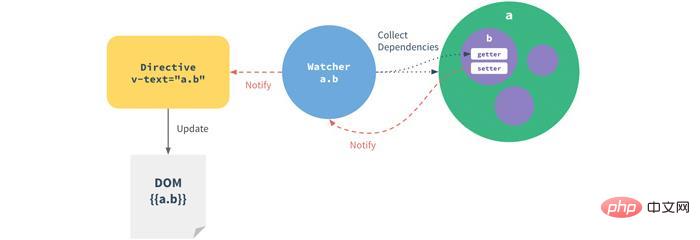 Web Front-end
Web Front-end
 Vue.js
Vue.js
 An article to understand the two-way binding principle of watcher data in Vue (with code)
An article to understand the two-way binding principle of watcher data in Vue (with code)
An article to understand the two-way binding principle of watcher data in Vue (with code)
In the previous article "Analysis of the two-way binding principle of observer data in vue (code sharing)", we learned about the two-way binding principle of observer data in vue. The following article will give you an understanding of the two-way binding principle of watcher data in Vue. It has certain reference value. Friends in need can refer to it.

##vue Data two-way binding principle and simple implementation, this article will implement of mvvm watcher

vue data two-way binding principle-observer
2)vue data two-way binding Defined principle-wather
3)vue data two-way binding principle-parser Complie
vuedata two-way binding principle, And simple implementation, this article will implement mvvmWatcher
watcher.Watcher The subscriber serves as the communication bridge between Observer and Compile , the main things it does are:
dep) when instantiating itself
update()Method
dep.notice(), you can call your own update() method and trigger it The callback bound in Compile releases itself.
1 2 3 4 5 6 7 8 9 10 11 12 13 14 15 16 17 18 19 20 21 22 23 24 25 26 27 |
|
1 2 3 4 5 6 7 8 9 10 11 12 13 14 |
|
Watcher, call the get() method, and pass Dep.target=watcherInstance Mark the subscriber as the current watcher instance and forcefully trigger the getter method defined by the property. When the getter method is executed, it will be in the property's subscriber depAdd the current watcher instance so that watcherInstance can receive update notifications when the property value changes.
MVVM
Here, first connect the listener Observer and the listener Watcher, and simulate some data first , implement simple data binding
1 2 3 4 5 6 7 8 9 10 11 12 13 14 15 16 17 18 19 20 21 22 23 |
|
div is initially hello world, and changes to chuchur after every second Adding timestamp, although it is implemented, is still far from what was imagined. It is vue.name not vue.data.name, so here you need to add a property proxy method to the Vue instance to access vm## The attribute proxy of # is to access the attributes of vm.data. The modified code is as follows: <div class="code" style="position:relative; padding:0px; margin:0px;"><pre class='brush:php;toolbar:false;'>function Vue(options) {
this.$options = options || {};
this.data = this.$options.data;
// 属性代理,实现 vm.xxx -> vm.data.xxx
var self = this;
Object.keys(this.data).forEach(function(key) {
self.proxy(key); // 绑定代理属性
});
observe(this.data, this);
el.innerHTML = this.data[exp]; // 初始化模板数据的值
new Watcher(this, exp, function(value) {
el.innerHTML = value;
});
return this;
}
Vue.prototype = {
proxy: function(key) {
var self = this;
Object.defineProperty(this, key, {
enumerable: false,
configurable: true,
get: function proxyGetter() {
return self.data[key];
},
set: function proxySetter(newVal) {
self.data[key] = newVal;
}
});
}
}</pre><div class="contentsignin">Copy after login</div></div> Then you can directly modify the template data through </p>vue.name<p> , the next step is to implement the parser <code>Complie [End]
Recommended learning:
vue.js tutorialThe above is the detailed content of An article to understand the two-way binding principle of watcher data in Vue (with code). For more information, please follow other related articles on the PHP Chinese website!

Hot AI Tools

Undresser.AI Undress
AI-powered app for creating realistic nude photos

AI Clothes Remover
Online AI tool for removing clothes from photos.

Undress AI Tool
Undress images for free

Clothoff.io
AI clothes remover

Video Face Swap
Swap faces in any video effortlessly with our completely free AI face swap tool!

Hot Article

Hot Tools

Notepad++7.3.1
Easy-to-use and free code editor

SublimeText3 Chinese version
Chinese version, very easy to use

Zend Studio 13.0.1
Powerful PHP integrated development environment

Dreamweaver CS6
Visual web development tools

SublimeText3 Mac version
God-level code editing software (SublimeText3)

Hot Topics
 How to use bootstrap in vue
Apr 07, 2025 pm 11:33 PM
How to use bootstrap in vue
Apr 07, 2025 pm 11:33 PM
Using Bootstrap in Vue.js is divided into five steps: Install Bootstrap. Import Bootstrap in main.js. Use the Bootstrap component directly in the template. Optional: Custom style. Optional: Use plug-ins.
 How to add functions to buttons for vue
Apr 08, 2025 am 08:51 AM
How to add functions to buttons for vue
Apr 08, 2025 am 08:51 AM
You can add a function to the Vue button by binding the button in the HTML template to a method. Define the method and write function logic in the Vue instance.
 How to use watch in vue
Apr 07, 2025 pm 11:36 PM
How to use watch in vue
Apr 07, 2025 pm 11:36 PM
The watch option in Vue.js allows developers to listen for changes in specific data. When the data changes, watch triggers a callback function to perform update views or other tasks. Its configuration options include immediate, which specifies whether to execute a callback immediately, and deep, which specifies whether to recursively listen to changes to objects or arrays.
 What does vue multi-page development mean?
Apr 07, 2025 pm 11:57 PM
What does vue multi-page development mean?
Apr 07, 2025 pm 11:57 PM
Vue multi-page development is a way to build applications using the Vue.js framework, where the application is divided into separate pages: Code Maintenance: Splitting the application into multiple pages can make the code easier to manage and maintain. Modularity: Each page can be used as a separate module for easy reuse and replacement. Simple routing: Navigation between pages can be managed through simple routing configuration. SEO Optimization: Each page has its own URL, which helps SEO.
 How to reference js file with vue.js
Apr 07, 2025 pm 11:27 PM
How to reference js file with vue.js
Apr 07, 2025 pm 11:27 PM
There are three ways to refer to JS files in Vue.js: directly specify the path using the <script> tag;; dynamic import using the mounted() lifecycle hook; and importing through the Vuex state management library.
 How to return to previous page by vue
Apr 07, 2025 pm 11:30 PM
How to return to previous page by vue
Apr 07, 2025 pm 11:30 PM
Vue.js has four methods to return to the previous page: $router.go(-1)$router.back() uses <router-link to="/" component window.history.back(), and the method selection depends on the scene.
 How to use vue traversal
Apr 07, 2025 pm 11:48 PM
How to use vue traversal
Apr 07, 2025 pm 11:48 PM
There are three common methods for Vue.js to traverse arrays and objects: the v-for directive is used to traverse each element and render templates; the v-bind directive can be used with v-for to dynamically set attribute values for each element; and the .map method can convert array elements into new arrays.
 How to jump to the div of vue
Apr 08, 2025 am 09:18 AM
How to jump to the div of vue
Apr 08, 2025 am 09:18 AM
There are two ways to jump div elements in Vue: use Vue Router and add router-link component. Add the @click event listener and call this.$router.push() method to jump.





